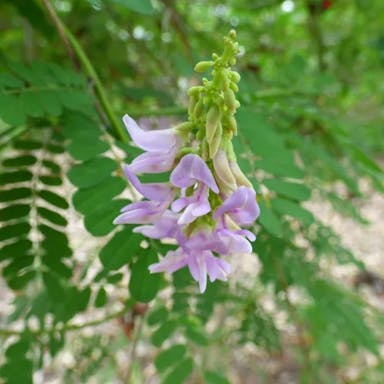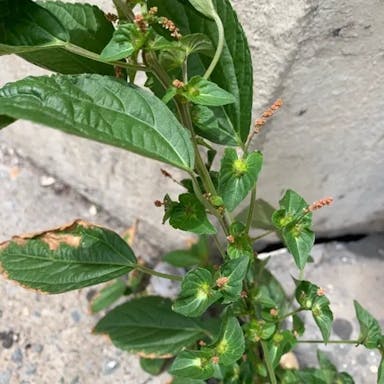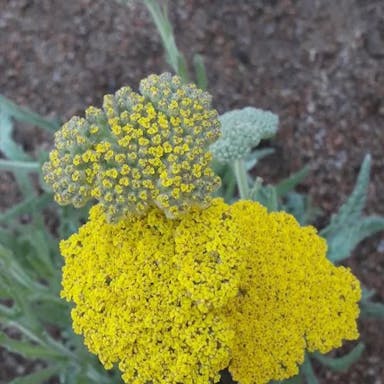Poley, also known as Teucrium polium, is a perennial herbaceous plant native to the Mediterranean region. It belongs to the Lamiaceae family, commonly referred to as the mint family. This plant is characterized by its small, white or pink flowers that bloom in clusters, attracting pollinators like bees and butterflies. Teucrium polium is known for its aromatic leaves, which have a slightly bitter taste. The plant is often used in traditional medicine for its potential health benefits. It is relatively easy to grow, thriving in well-drained soil and full sun. Teucrium polium can reach a height of about 30-60 cm, making it a compact plant suitable for gardens or containers. There are different varieties of Teucrium polium, each with its unique characteristics. The fruit of this plant is small and inconspicuous, typically not a significant feature. Overall, Teucrium polium is a versatile plant with ornamental and medicinal value.
Poley
- Scientific name
- Teucrium polium
Basic Information
- Lamiaceae Family Teucrium Genus Poley Species
- Lamiaceae > Teucrium > Teucrium polium
- 83%
- The Completeness of This Encyclopedia
Please help us complete the encyclopedia, Terrarium is a encyclopedia service to be completed with everyone in the world. Currently, this page is 83% complete. For more information on how to contribute, please click here.
- Forb/herb
- Perennial
- Subshrub
- Height
- 30cm ~
- Flower Color
- Leaf Color
- Anthesis
- summer
- Sunlight Exposure
Full Sun Long hours of sunlight from morning to afternoon Partial Shade A location in the shade of a tree or where either the morning or afternoon is shaded Full Shade A place where there is no direct sunlight
- Full Sun
- Hardiness Zones
This is an indicator to know to which zone each plant can winter. Knowing the zone of each plant gives you an idea of the cold temperature resistance when grown in the ground without a roof. 2: -42.7 to -40.0 3: -39.9 to -34.4 4: -34.3 to -28.9 5: -28.8 to -23.3 6: -23.2 to -17.8 7: -17.7 to -12.2 8: -12.1 to -6.7 9: -6.6 to -1.1 10: -1.0 to 4.4 11: 4.5 to 10.0
- 8
- Cold resistance
- Good
- Heat resistance
- Good
- Habitat of origin
- Mediterranean region
- Growth Rate
- Normal
What is Poley (Teucrium polium)?
What is Poley (Teucrium polium)
Flower meaning
The flower language commonly used in America for the plant called Poley is as follows: - Poley: Independence, resilience, and strength. - Poley: Overcoming challenges and standing tall in adversity. - Poley: Symbolizes courage and determination. One typical example is: - Poley: Represents the ability to thrive in difficult situations, inspiring others to persevere.
Calendar of Poley (Teucrium polium)
Calendar
Poley flowers in the United States typically bloom in late spring to early summer. The plant's flowers are at their best during the month of June. Blooming usually occurs once a year, lasting for about 2-3 weeks. To extend the blooming period, ensure the plant receives adequate sunlight, water, and nutrients. Deadheading spent flowers can also promote continuous blooming. Maintaining consistent soil moisture and avoiding extreme temperature fluctuations can help prolong the flowering season. Pruning any damaged or diseased parts of the plant can redirect energy towards flower production. Additionally, applying a balanced fertilizer during the growing season can support healthy blooming.
How to grow Poley (Teucrium polium)
Watering
For the plant Poley, water every 7-10 days during the growing season, ensuring the soil is moist but not waterlogged. During winter, reduce watering frequency to every 14-21 days, allowing the soil to partially dry out between waterings. Adjust watering based on soil humidity; water more frequently in dry conditions and less in humid environments. Water in the morning to prevent excess moisture at night, which can lead to root rot. Avoid overwatering as it can cause root rot and other issues. Use a well-draining soil mix to prevent waterlogging and promote healthy root growth.
Soil and Fertilizer
Poley thrives in well-draining soil with a pH level between 6.0 and 7.0. It requires a balanced fertilizer with an N-P-K ratio of 10-10-10 for optimal growth. Fertilizer should be applied in early spring before new growth begins, and again in mid-summer to support flowering. Apply fertilizer at a rate of 1 tablespoon per square foot of soil, avoiding direct contact with the plant's base. Regularly check soil moisture levels to prevent over-fertilization. High-quality organic matter can improve soil structure and nutrient retention, benefiting Poley's overall health and development.
Sunlight and Place
Poley thrives in full sun to partial shade, requiring at least 6 hours of direct sunlight daily. It exhibits moderate cold tolerance, able to withstand temperatures as low as 20°F (-6°C). Poley is highly heat tolerant and prefers temperatures between 65-75°F (18-24°C). During summer, it should be placed in a location with some afternoon shade to prevent scorching. In winter, it can be overwintered indoors near a sunny window. This plant benefits from consistent sunlight exposure, but it can also adapt to lower light conditions. It is essential to monitor its response to sunlight and adjust placement accordingly.
Advanced Information of Poley (Teucrium polium)
Pruning
Poley should be pruned to maintain its shape, promote new growth, and remove dead or diseased branches. Pruning is essential to enhance the plant's overall health and appearance. The best time to prune Poley is in late winter or early spring before new growth begins. When pruning, use clean, sharp tools to make precise cuts at a 45-degree angle just above a leaf node or bud. Remove any crossing or crowded branches to improve air circulation and prevent disease. After pruning, water the plant thoroughly and apply a balanced fertilizer to support regrowth. Regular pruning will help Poley thrive and remain vigorous.
Planting and Harvest
Poley should be potted in well-draining soil with good aeration to prevent waterlogging, promoting healthy root growth. Ensure the pot has drainage holes to prevent excess water accumulation, avoiding root rot. When repotting, choose a slightly larger pot to accommodate root growth, refreshing the soil mix to provide nutrients. Mist the leaves occasionally to maintain humidity levels, preventing dehydration. Regularly check for pests and diseases, addressing them promptly to maintain plant health.
Propagation
Poley can be propagated through seeds, division, and cuttings. Seeds are sown in well-draining soil, kept moist, and placed in a warm, sunny location. Division involves separating the plant into smaller sections with roots attached. Cuttings are taken from healthy stems, dipped in rooting hormone, and planted in a suitable growing medium. Leaf cuttings can also be used by taking a healthy leaf, placing it in soil, and keeping it moist until roots develop. To ensure successful propagation, it is recommended to use a combination of methods to increase the chances of success and to harvest seeds or cuttings at the appropriate time.
Pests and Diseases
Poley is susceptible to various pests and diseases, including aphids, spider mites, and powdery mildew. These pests can weaken the plant by sucking sap or causing damage to the leaves. Aphids are small insects that feed on plant sap, leading to stunted growth and distorted leaves. Spider mites are tiny arachnids that also feed on sap, causing yellowing and stippling of leaves. Powdery mildew is a fungal disease that appears as a white powdery substance on the leaves, inhibiting photosynthesis. To prevent these issues, regular inspection of the plant for early signs of infestation is crucial. Maintaining proper air circulation around the plant and avoiding overhead watering can help prevent powdery mildew. Additionally, using insecticidal soap or neem oil can help control aphids and spider mites.
Habitat of Poley (Teucrium polium)
Habitat
Toxicity of Poley (Teucrium polium)
Health Benefits
- edible
- Inedible
- Toxic
- toxic
NO DATA
Toxic for dogs and cats
NO DATA
Q&A of Poley (Teucrium polium)
- Is there a recommended way to choose Poley?
Poley seedlings should have sturdy stems and healthy leaves without any signs of discoloration or wilting. Check for well-developed root systems, avoiding root-bound containers. Opt for seeds that are plump, uniform in size, and free of mold or damage. Ensure the seeds are from a reputable source to guarantee quality. When selecting different varieties, consider 'Silver Tails' for its silvery foliage, 'Golden Glow' for its yellowish leaves, and 'Purple Haze' for its purple-tinged stems. Each variety offers unique characteristics that can enhance your garden.
0
0












